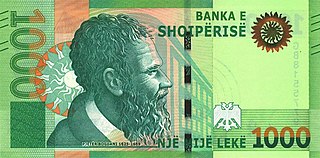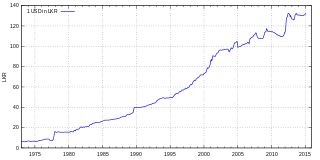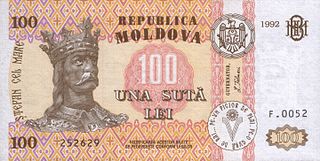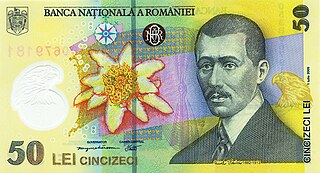
The lek is the currency of Albania. Historically, it was subdivided into 100 qintars.

The Bangladeshi taka is the currency of the People's Republic of Bangladesh. In Unicode, it is encoded at U+09F3৳.

The Sri Lankan Rupee is the currency of Sri Lanka. It is subdivided into 100 cents, but cents are rarely seen in circulation due to its low value. It is issued by the Central Bank of Sri Lanka. The abbreviation Re (singular) and Rs (plural) is generally used, the World Bank suggests SL Rs as a fully disambiguating abbreviation for distinction from other currencies named "rupee".

Banknotes of the Philippine peso are issued by the Bangko Sentral ng Pilipinas for circulation in the Philippines. The smallest amount of legal tender in wide circulation is ₱20 and the largest is ₱1000. The front side of each banknote features prominent people along with buildings, and events in the country's history while the reverse side depicts landmarks and animals.

The leu is the currency of Moldova. Like the Romanian leu, the Moldovan leu is subdivided into 100 bani. The name of the currency originates from a Romanian word which means "lion".

The Romanian leu is the currency of Romania. It is subdivided into 100 bani, a word that means both "money" and "coin" in the Romanian language.

The kyat is the currency of Myanmar (Burma). The typical notation for the kyat is "K" (singular) and "Ks." (plural), placed before the numerals followed by /-.
The guaraní is the national currency unit of Paraguay. The guaraní was divided into 100 céntimos but, because of inflation, céntimos are no longer in use.
Since 1867 there have been four successive currencies in Romania known as the leu. This article details the banknotes denominated in the leu and its subdivision the ban since 1917, with images.

The current one leu banknote is the smallest circulating denomination of the Romanian leu. It is the same size as the 5 Euro banknote.

The five lei banknote is one of the circulating denomination of the Romanian leu. It is the same size as the 10 Euro banknote.

The fifty-lei banknote is one of the circulating denomination of the Romanian leu. It is the same size as the 50 Euro banknote.

The one hundred lei banknote is one of the circulating denomination of the Romanian leu. It is the same size as the 2002 series 100 Euro banknote.

The two hundred lei banknote is one of the circulating denomination of the Romanian leu.

The five hundred lei banknote is the highest of the circulating denomination of the Romanian leu. It is the same size as the 200 Euro banknote.
The fifty-bani coin is a coin of the Romanian leu. The fifty-bani is also the only coin of Romania to not be steel-based, but be made completely of an alloy, and was also the first coin in the country to have a written inscription on its edge, with the introduction of 4 new coins in 2019.
The one leu coin was a coin of the Romanian leu. Introduced in 1870, it last circulated between 1992 and de facto 1996, when it was the lowest-denomination coin in the country. It was considered as circulating coin for accounting reasons and was still minted in proof sets until the 2005 denomination of the currency.

The currency of Indonesia, the rupiah, has a long history dating back to its colonial period. Due to periods of economic uncertainty and high inflation, the currency has been re-valued several times.
The Coins of the Romanian leu have been issued since the introduction of the Romanian leu in 1867.
The National Bank of Ukraine has issued four banknote series since 1996. All banknotes in denominations of ₴1, ₴2, ₴5, ₴10, ₴20, ₴50, ₴100, ₴200, ₴500 and ₴1,000 issued after 2003 are considered legal tender. All of them depict an important person in Ukraine's history on the obverse and a landmark place on the reverse. The lowest four denominations are no longer issued in banknotes and are intended to be gradually substituted by coins, though they remain common. There have been four commemorative banknote issues.




















